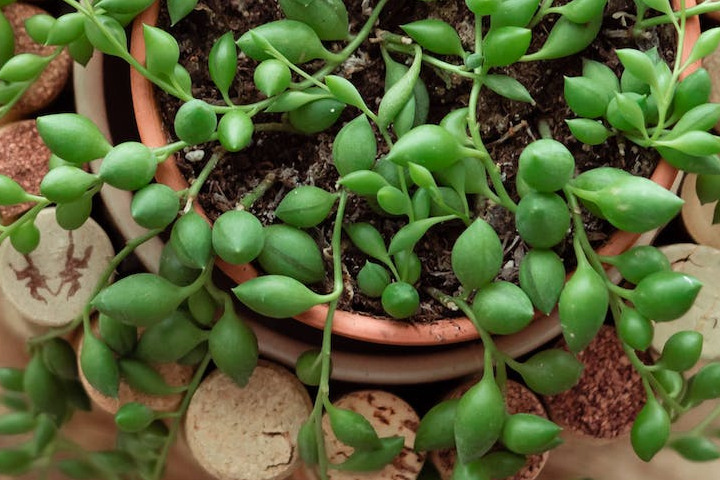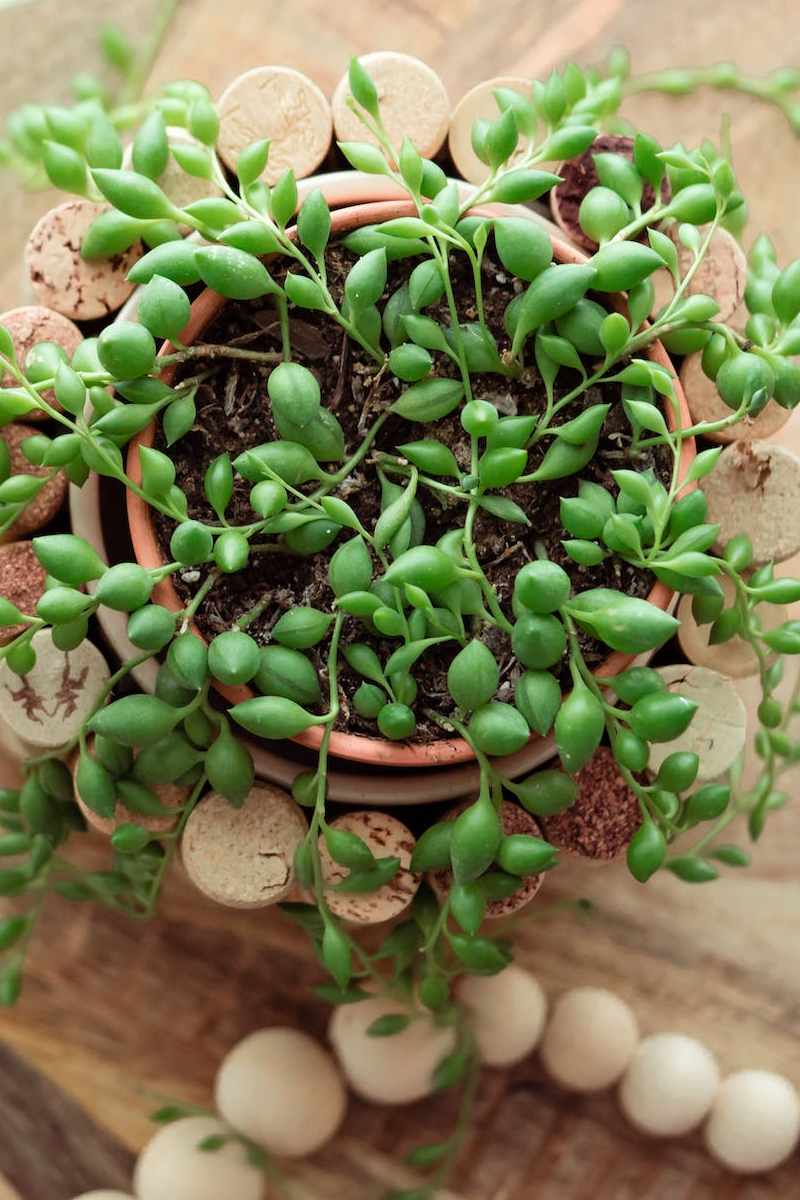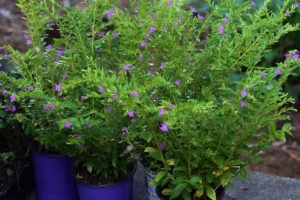
Table of Contents
Variegated String of Pearls: The Complete Guide and Care Instructions
The Variegated String of Pearls is a classic choice for all the succulent plant lovers out there. This guide will take you through everything you need to know about caring for this plant. The Variegated String of Pearls also goes by the botanical name Curio rowleyanus.
It’s different from the regular string of beads, its relative. The Variegated String of Pearls has green bead leaves with cream-colored streaks. They almost resemble wasabi peas. The Variegated String of Pearls has a lower amount of chlorophyll. Due to this, it has a slower growth and a less green color than the regular string of pearls.
These white-streaked ‘pearls’ or beads sit amidst thin, green stems. These leaves don’t grow very tall. Instead, they tend to trail down to a length of up to 2 feet. When cared for properly, the Variegated String of Pearls will make a pleasant addition to any home!
Blooming
The Variegated String of Pearls blooms small, white flowers that radiate a homey, cinnamon scent. In order to help this stunning plant bloom, you should reduce the watering. Make sure you keep this plant under steady temperatures of around 60 degrees during the winter season.
Keeping this plant dry and cool during the winter will increase the chances of it blooming during the summer. The blooming season for the plant lasts around a month, from late spring through summer.
Since the Variegated String of Pearls needs a lot of sunlight to bloom, you need to create the perfect conditions for it if you keep it inside. It’s important to position it where it has access to sunlight. To encourage that, you can place this plant near a windowsill.
How to Plant Variegated String of Pearls?
If you search how to plant Variegated String of Pearls, you will hear two opposing views. Some people say it is very hard to plant them, while others purport it’s very easy. There is also a lack of information available online, so we’ll tell you everything you need to know.
Before you think it’s not possible, let us tell you that it is very easy to grow this plant if you’re able to meet certain conditions. These plants originate in East Africa, so replicating its natural habitat will help you immensely.
The Variegated String of Pearls needs a fast-draining soil. While many people use a potting mix that is made for succulents, adding coarse pumice to the mix would help even more. This plant needs the most draining soil mix you can find to grow.
Due to where it grows, the Variegated String of Pearls experiences long periods of drought. This is why you should avoid overwatering it as the plant can rot. These plants have a compact root system so do not pot it in a large pot. Use a small pot with well-draining soil.
If you live in a warm climate, you can plant the Variegated String of Pearls in the ground. They will easily grow, but be careful if you have any pets around. The String of Pearls can be poisonous for human and animal consumption.
Different Types of Variegated String of Pearls
The String of Pearls has several relatives, with minor differences, especially in color. This is what makes this plant so aesthetic. Let’s look at the different kinds of Variegated String of pearls.
Purple Variegated String of Pearls
This variety of the Variegated String of Pearls is commonly known as the String of Watermelon. Its botanical name is Curio herreanus. It is characterized by melon shaped leaves with purple streaks.
Pink Variegated String of Pearls
This variety of the Variegated String of Pearls is also known as the Ceropegia Woodii or the String of Hearts.
This trailing succulent has long, purple stems with heart-shaped leaves. The underside of the leaves is pink, giving the plant a pop of color.
How to Propagate Variegated String of Pearls
The Variegated String of Pearls will grow about 5 to 15 inches every year. They are generally not a fast-growing plant, and this growth may be less if you don’t propagate the plant. On average, the Variegated String of Pearls will survive for 5 years. However, you can prolong their lifespan with proper propagation!
The Variegated String of Pearls will propagate easily and quickly through stem cuttings. The best time to propagate this plant is during spring or summer, and even early fall. This will vary depending on where you live.
Basically, you should propagate it during a warmer climate. You may also propagate it through planting seeds, but this method is usually not that successful.
Stem Cuttings
- Use a pair of sterilized pruning snips or scissors, a small, 4 to 6-inch pot and a well-draining soil mix, preferably with coarse pumice. Do not use a larger pot.
- Use these scissors or snips to cut several 4-5 inch long stems from right under a healthy leaf node of your existing plant.
- Get rid of the two bottom leaves from the trimmed stems to allow them to adhere to the soil better. It is advised that you let these stems rest for 1-2 days before planting so that the callus can develop.
- Now fill your pot with the succulent soil. There’s no need to water because the pearls already have sufficient water and nutrients.
- Make a hole in the center of the pot where you want to plant the stems.
- Carefully place the stem cuttings in the hole, about an inch deep. Make sure the leaves are above the soil mix. Wait a few days before you water the plant.
- If outdoors, place the plant in partial sunlight. If indoors, place it in a bright spot.
How to Care for Variegated String of Pearls?
Even though the Variegated String of Pearls is a unique plant, it does not require out of the ordinary care. If you want any plant to thrive, imitate the conditions of its natural habitat. The Variegated String of Pearls hails from Eastern Africa, so it naturally requires a lot of sunlight but low watering.
Here are some important care requirements for this plant:
Light
The Variegated String of Pearls needs a combination of direct and indirect sunlight. If you plan to keep it indoors, make sure it’s placed in a spot where it gets sunlight, like near the window. If you plan to keep it outdoors, make sure it is not under constant direct sunlight.
Ideally, this succulent plant needs around 6-8 hours of sunlight a day. To make sure it gets just that, place it in direct sunlight for the softer morning hours. Shift it to a spot where it gets indirect sunlight for the rest of the day. Partial shade is best for it when the afternoon sun is particularly harsh.
Water
If you want to grow this plant, you need to use a well-draining soil as this plant does not require too much moisture. The soil should be slightly moist during the growing season, spring through summer. Reduce the watering during the winter season to allow it to grow properly. If you see the leaves going flat, you could then increase the frequency of watering.
Ideally, you should water the Variegated String of Pearls every 7 to 14 days. This will vary depending on the humidity and rainfall in the place where you live. If you’re based in a hotter climate, you should water the plant closer to 7 days. Alternatively, you can touch the soil and check.
If the first half-inch of the soil feels dry to touch, this is a sign the plant needs water. The best way is to water thoroughly and then make sure the soil drains well.
Soil
You can use any succulent potting soil for this particular plant. Just make sure it is well-draining. Overly moist soil can cause the plant’s roots to rot. In order to boost its growth, you can use sandy soil. Alternatively, you can use a 3 to 1 ratio of soil to sand.
To ensure proper drainage, you should use terra cotta and clay pots that help do away with any excess moisture. You can also ensure a sufficient number of draining holes at the bottom of the container. You can add around 25% of pumice to any soil and keep it well-drained and well-aerated. That’s all it takes!
Fertilizer
You will need to feed this plant fertilizer two times a week, especially during the growing season. Ideally, you should use a water-soluble fertilizer. Make sure you dilute this fertilizer to half its strength. During the winter season when the plant isn’t actively growing, feeding it every six weeks should be sufficient.
Temperature
Due to its natural place of birth, this plant thrives in warm temperatures. It needs consistently high temperatures of around 50 to 60 degrees Fahrenheit during the growing season. During the winter season, it needs an even higher temperature of around 70 degrees Fahrenheit.
Common Problems with Variegated String of Pearls (and How to Fix Them)
The prime issue the Variegated String of Pearls faces has to do with overwatering. Otherwise, it rarely experiences disease, which is another reason to keep this stunning plant. Here are some of the most common issues that this plan experiences with solutions!
Root Rot
The Variegated String of Pearls needs little water. Overwatering it can result in root rot. When you water this plant, you should immediately drain it, possibly within the first few minutes. If the soil remains wet for very long, the roots will rot as the air won’t circulate properly. You would detect root rot by the foul smell coming from the soil or spotting yellowing leaves.
Solution:
In such an event, carefully remove and wash the roots to get rid of the moist soil. Proceed to repot the plant and chop off any dead leaves.
To avoid root rot, take the following measures. For starters, make sure you use a well-draining soil potting mix. Some reasons behind slow draining soil include a large pot, high humidity, and the incorrect soil mix.
Use a small pot, use a succulent potting mix with pumice and make sure you drain the soil after watering the plant every 7 to 14 days, or when the soil is completely dry to the touch. Do not overwater!
Mealybugs
While the Variegated String of Pearls does not usually fall prey to most pests, mealybugs still target it. These small, winged insects thrive in warmer temperatures. You would usually spot them around the leaf nodes.
Solution:
To get rid of these insects, prune out the areas it has occupied. You may also apply some alcohol to the areas where mealybugs were present. Use insect spray or some soapy solution to wash the rest of the area.
Repeat this until the plant is completely insect-free.
Aphids
Aphids are green, black, or white insects that take refuge in succulents like the Variegated String of Pearls. Much like mealybugs, they occupy the crevices of the plant, like stem joints and the leaf nodes.
Solution:
To get rid of them, apply a cotton ball soaked in alcohol to the affected area. Proceed to spray it with a disinfectant spray.
Are Variegated Strings of Pearls Rare?
Variegated Strings of Pearls are rare and unique plants. They are often very tricky to grow, and there is a limited number of growers of this plant in the U.S. However, there are some small nurseries that sell this plant online. Fortunately, they are affordable, so you don’t have to worry about procuring one.



